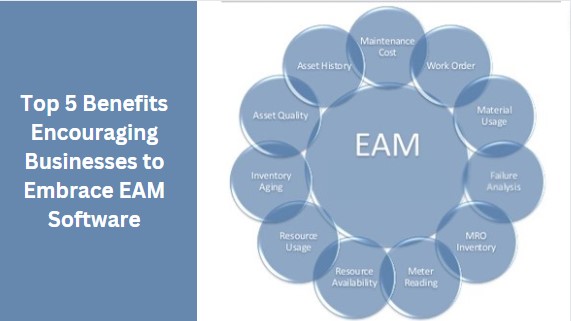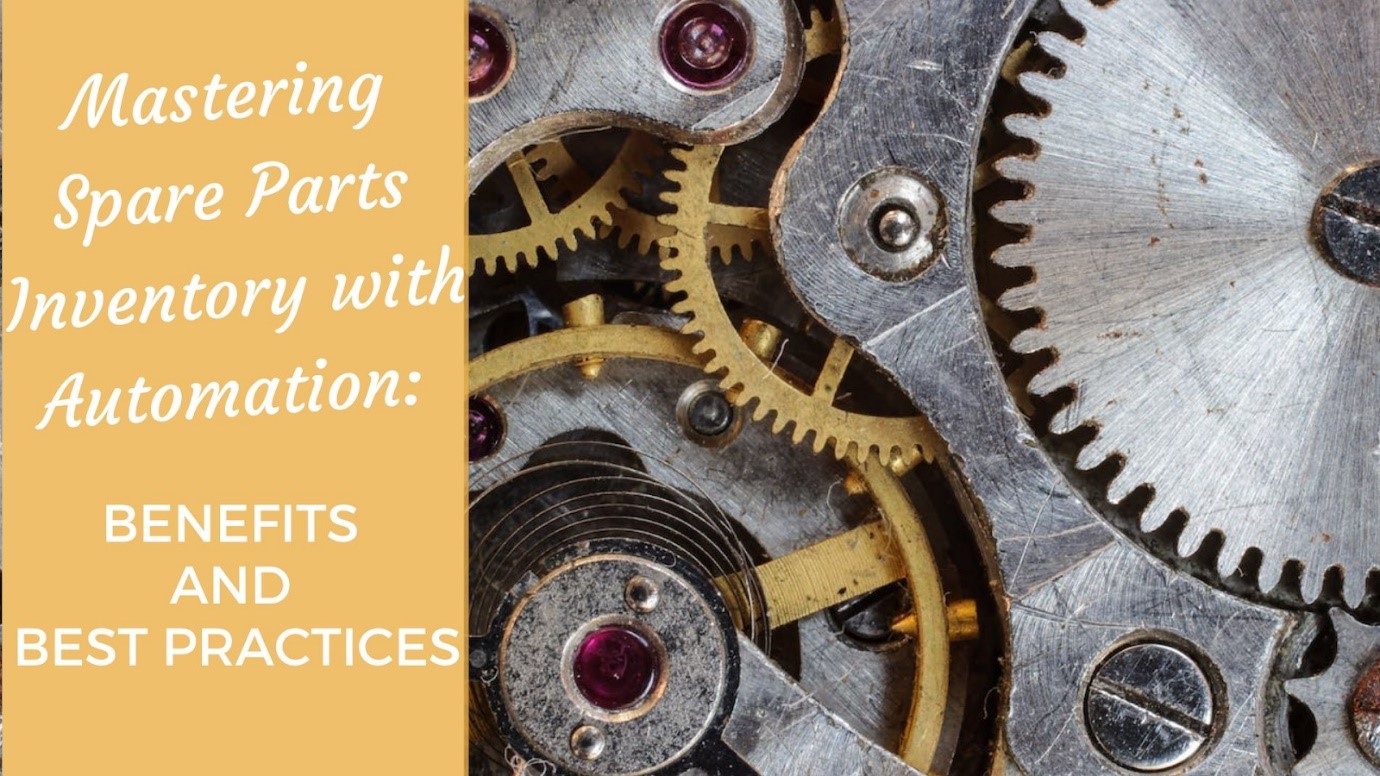
5 reasons why businesses should implement EAM software
Pratik Lohiya |
05 Jan 2024 |
18:13 PM
- Defining Enterprise Asset Management (EAM) Software
- Understanding the Importance and Scope of EAM in Business Operations
- The Core Reasons for Implementing EAM Solutions
- Five Key Reasons to Adopt EAM Solutions
- Understanding Enterprise Asset Management Software
- EAM Software's Impact on Facilities and Operations
- Benefits of Enterprise Asset Management solution
- How EAM Software Assists in Avoiding Asset Breakdowns
- Conclusion: Embracing EAM Software for Business Success

Mastering Spare Parts Inventory with Automation: Benefits and Best Practices
Madhurima Sanyal 11 May 2024 | 12:13 PMDiscover how automation is revolutionizing parts inventory management today. Learn about the challenges of handling spare parts and the best practices of the transformative power of automation in making your organization more competitive. Get a glimps...
Enterprise Asset Management (EAM) Software plays a pivotal role in modern business operations, facilitating the streamlined control and optimization of assets.
Defining Enterprise Asset Management (EAM) Software
At its core, EAM Software serves as a comprehensive tool designed to oversee and manage an organization's diverse array of assets effectively. These assets encompass physical entities such as machinery, equipment, facilities, and even digital resources like software licenses and intellectual property. The primary goal of EAM is to ensure optimal asset utilization, minimize downtime, and maximize their lifespan.
By integrating various functionalities like maintenance scheduling, preventive maintenance and performance analysis, EAM solutions provide a centralized platform for monitoring and maintaining assets throughout their lifecycle. Through sophisticated data management and analytics, EAM systems enable businesses to make informed decisions, enhance operational efficiency, and allocate resources judiciously.
Understanding the Importance and Scope of EAM in Business Operations
The scope of EAM solution embraces a strategic approach to asset management, emphasizing the integration of technology to streamline operations. EAM's significance lies in its ability to forecast maintenance needs, preemptively identify potential issues, and optimize asset performance.
In today's competitive landscape, businesses grapple with challenges such as rising maintenance costs, regulatory compliance, and the need for enhanced productivity. EAM emerges as a solution that not only addresses these challenges but also empowers organizations to harness their assets' full potential.
Furthermore, with the evolution of technology, EAM systems have adapted to accommodate cloud-based solutions, IoT integrations, and data-driven insights. These advancements propel businesses towards a future where asset management isn't just reactive but predictive and preventive, ultimately bolstering their bottom line.
By embracing EAM solutions, businesses can proactively manage their assets, reduce operational risks, and pave the way for sustained growth and success.
The Core Reasons for Implementing EAM Solutions
Exploring the Need for EAM in Organizational Settings
The dynamic landscape of modern enterprises demands efficient asset management strategies. Organizations grapple with numerous challenges: escalating maintenance costs, regulatory compliance, asset performance optimization, and resource allocation complexities. Implementing EAM solutions addresses these challenges head-on by providing a centralized platform for comprehensive asset oversight.
EAM software ensures a systematic approach to asset management, enabling businesses to monitor asset lifecycle and forecast maintenance needs. By facilitating data-driven decision-making, EAM empowers organizations to proactively address potential issues, thereby reducing downtime and enhancing operational efficiency.
Five Key Reasons to Adopt EAM Solutions
Integrating Enterprise Asset Management (EAM) software emerges as a strategic imperative for sustainable growth and operational excellence. Let's understand the quintessential reasons why businesses should embrace EAM solutions.
Harnessing Valuable Insights
EAM software empowers businesses by providing actionable insights derived from robust data analytics. By leveraging historical and real-time data, organizations gain a comprehensive understanding of their assets' performance. These insights allow proactive decision-making, facilitating optimized resource allocation and strategic planning.
Elevating Asset Performance
Through predictive maintenance capabilities, businesses preemptively identify and address potential issues, minimizing downtime and maximizing operational efficiency. Real-time monitoring and analysis further aid in identifying underperforming assets, enabling targeted improvements.
Cost Reduction Strategies
One of the pivotal advantages of enterprise asset management software lies in its ability to drive cost savings. By implementing predictive maintenance schedules and optimizing asset utilization, businesses significantly reduce maintenance costs while extending asset lifespans. This proactive approach mitigates unexpected breakdowns, minimizing repair expenses and enhancing budgetary control.
Eradicating Duplicate Tasks
EAM solutions streamline workflows by eliminating redundancies and duplicate tasks. Through centralized asset management, organizations avoid overlapping efforts and ensure streamlined operations. This leads to enhanced productivity and resource optimization across various departments, fostering a cohesive and efficient work environment.
Preventing Asset Breakdowns and Enhancing Reliability
Proactive maintenance and predictive analytics provided by enterprise asset management software contribute to preventing asset breakdowns. By identifying potential issues beforehand, businesses preempt costly disruptions, ensuring consistent operational reliability. This reliability bolsters confidence in operations and minimizes unexpected downtimes.
Adopting EAM solutions isn't merely about asset tracking; it's about embracing proactive strategies that optimize operations, reduce costs, and elevate business performance holistically.
Understanding Enterprise Asset Management Software
Diving into the Features and Capabilities of EAM Solutions
Enterprise asset management is a versatile tool equipped with an array of features that streamline asset management processes. These solutions offer functionalities like predictive maintenance, asset lifecycle management, inventory tracking, and compliance management. With real-time data accessibility, businesses gain insights into equipment health, facilitating informed decision-making and proactive maintenance strategies.
Enterprise asset management also integrates with Internet of Things (IoT) devices, enabling remote monitoring and automated data collection. This integration enhances asset lifecycle monitoring, reducing downtime, and optimizing operational efficiency across industries.
Managing Different Types of Assets with EAM Software
Businesses deal with a variety of assets, ranging from equipment and machinery to infrastructure and facilities. EAM solutions provide a unified platform to manage these diverse asset types effectively. Whether it's scheduling maintenance for machinery in manufacturing plants or tracking the lifecycle of IT assets in an office setting, it caters to the unique needs of different asset categories.
Moreover, EAM systems adapt to the specific requirements of asset-intensive industries, such as manufacturing, healthcare, utilities, and transportation. They facilitate seamless management of linear assets, fixed assets, and other specialized equipment that ensure regulatory compliance and optimizes equipment performance.
Enterprise Asset Management software isn't just a tool for tracking assets; it's a holistic solution that revolutionizes asset management practices, offering a unified platform to streamline operations and maximize asset value.
EAM Software's Impact on Facilities and Operations
Discussing the Significance of EAM for Efficient Facility Management
EAM deployment revolutionizes facility management by offering a comprehensive suite of tools for overseeing assets across various locations. Through centralized asset tracking and maintenance scheduling, EAM empowers facility managers to proactively monitor asset health, ensuring optimal performance and minimizing unplanned downtime.
EAM solutions enable the seamless coordination of maintenance activities, providing real-time insights into asset conditions. By leveraging predictive maintenance capabilities, facilities can conduct timely repairs and prevent potential breakdowns, thereby ensuring operational continuity and maximizing asset lifespan.
Optimizing Operations through EAM Software Implementation
Beyond efficient facility management, Enterprise Asset Management solution profoundly impacts overall operations. By integrating asset management processes, organizations achieve streamlined workflows and resource optimization. EAM's data-driven approach facilitates informed decision-making, allowing businesses to allocate resources judiciously and prioritize critical operational aspects.
Moreover, EAM fosters a culture of cost-efficiency by identifying redundant processes and eradicating duplicate tasks. This streamlined operational framework enhances productivity, reduces operational expenses, and fosters a leaner, more efficient organizational structure.
EAM software's implementation transcends mere operational enhancements; it aligns businesses toward proactive asset management strategies, thereby fortifying their operational resilience and competitive edge.
Benefits of Enterprise Asset Management solution
Implementing EAM yields substantial benefits by not only managing assets effectively but also contributing to overall operational excellence, compliance adherence, and strategic decision-making within an organization.
Some of the key advantages include:
-
Enhanced Operational Efficiency: EAM deployment streamlines workflows by automating maintenance schedules, allowing businesses to allocate resources effectively. This optimized workflow minimizes downtime and maximizes productivity.
-
Cost Reduction Strategies: Through predictive maintenance and optimized asset utilization, EAM significantly lowers maintenance costs, eliminating unnecessary expenditures.
-
Elimination of Duplicate Tasks: Enterprise Asset Management system integrate various processes, eliminating redundancy and ensuring a streamlined workflow without duplicate efforts.
-
Improved Asset Health: Real-time monitoring and analytics offered by EAM systems enable businesses to identify underperforming assets promptly, optimizing their functionality and extending their lifecycle.
-
Preventive Measures Against Asset Breakdowns: With predictive analytics, right EAM software helps organizations anticipate potential breakdowns, allowing proactive maintenance to prevent costly disruptions.
Implementing EAM solution embodies a proactive approach to maintenance operations, empowering businesses to navigate challenges effectively and thrive in a competitive landscape.
How EAM Software Assists in Avoiding Asset Breakdowns
One of the critical facets of EAM software is its proactive approach to scheduling asset maintenance. By leveraging predictive analytics and historical data, EAM systems forecast potential breakdowns, enabling preemptive maintenance. This preventive strategy helps organizations avoid costly downtimes and sudden equipment failures, ensuring seamless operations.
Leveraging EAM Solutions to Streamline Operations and Minimize Errors
Enterprise Asset Management system isn't solely about asset monitoring; it's a comprehensive solution that streamlines various operational aspects. By centralizing data and automating workflows, businesses can minimize human errors, optimize resource allocation, and enhance overall productivity. Furthermore, these solutions offer real-time insights to maintenance team, empowering asset managers to make informed choices for improved efficiency.
The amalgamation of EAM software with robust asset management practices not only mitigates risks but also maximizes asset utilization, reducing operational costs significantly.
Conclusion: Embracing EAM Software for Business Success
As businesses navigate the complexities of modern-day operations, the adoption of Enterprise Asset Management (EAM) Software emerges as a strategic move towards ensuring efficiency, reliability, and sustained growth.
The implementation of Enterprise Asset Management system offers a transformative approach to business operations. By leveraging EAM software, organizations gain a competitive edge through enhanced asset visibility, predictive maintenance capabilities, and streamlined workflows. This results in reduced downtime, optimized resource utilization, and ultimately, increased profitability. Embracing EAM solution paves the way for sustained growth and resilience in today's dynamic market landscape.
By fostering a culture of proactive equipment management and operational optimization, businesses position themselves for long-term success and market leadership. The proactive approach facilitated by EAM software fosters a robust foundation for growth, allowing companies to adapt swiftly to market shifts and evolving customer demands.